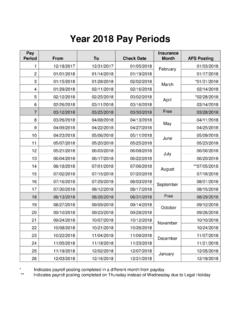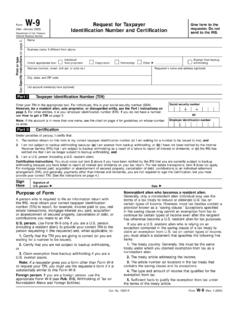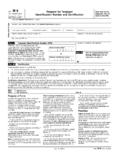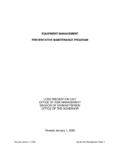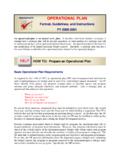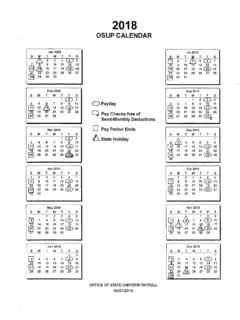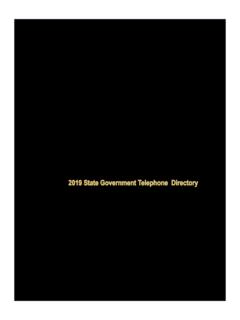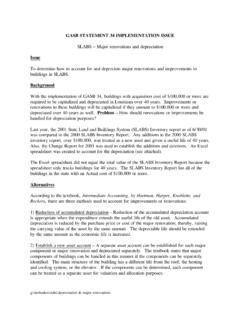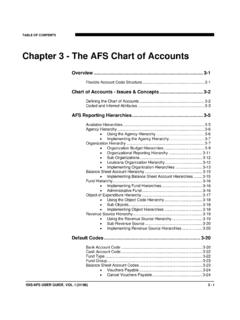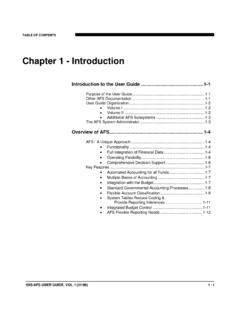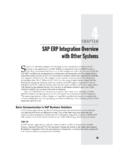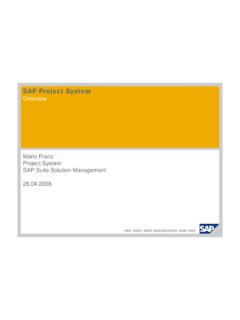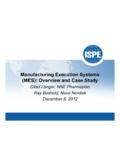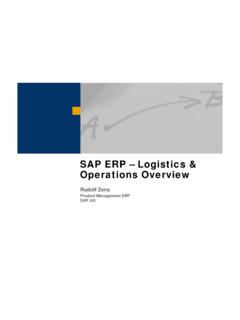Transcription of MRP and Forecasting Views in SAP Material Master and …
1 MRP and Forecasting Views in SAP Material Master and MRP Org. Structure LOG -MD-004. LOG-MD-004. October 7, 2008. LaGOV. Version Updated: 10/02/2008. Agenda Logistics, Ground Rules & Introduction Workshop Objectives Project Overview/Timeline Business Process Review As Is Process Discussions SAP terms glossary Process improvement opportunities SAP concepts & functionality Leading practices Enterprise readiness challenges Action Items Questions Friday, November 07, 2008 2. Logistics Before we get started .. Friday, November 07, 2008 3. Ground Rules Has everybody signed in? Everybody participates blueprint is not a spectator sport Silence means agreement Focus is key please turn off cell phones and close laptops Challenge existing processes and mindsets Offer suggestions and ideas Think Enterprise Ask questions at any time One person at a time please Creativity, cooperation, and compromise Friday, November 07, 2008 4. Introduction Roles Process Analyst and Functional Consultant (IBM).
2 Lead and facilitate the discussions and drive design decisions Documenter (State Employee) take detailed notes to support the formal meeting minutes to be sent by the Process Analyst to all participants for review and feedback Team Members (LaGov) provide additional support for process discussions, address key integration touch points Subject Matter Experts advise team members on the detailed business process and participate in the decisions required to design the future state business process Round the Room Introductions Name Position Agency Friday, November 07, 2008 5. Project Phases Five Key Phases Realization Preparation Preparation Business Blueprint Support Go Live Project Final and Strategy & Approach Defined Development & Unit Testing Go-Live Support Project Team Training Integration Testing Performance Tuning End-User Training Materials Business Process Definition User Acceptance Development Requirements Technical Testing End-User Training Conversion Friday, November 07, 2008 6.
3 Tentative Project Timeline Tentative implementation dates are planned as follows: Functionality Tentative Implementation Date Budget Prep October 2009. DOTD February 2010. Core Modules All Agencies July 2010. Additional Modules January 2011. May June 2008 July 2008 August Dec 2008 January 2009. Project Start-Up Phased deployment Blueprint will be confirmed/updated before completion of Blueprint activities! Friday, November 07, 2008 7. Blueprint Schedule - Tentative Please refer to the handout for the upcoming Blueprint Sessions Friday, November 07, 2008 9. Blueprint Objectives 1. Review and discuss the current or As-Is Business Processes: Which helps to drive out the business requirements As well as the integration points with other processes 2. Define Master Data Address key integration points Support organizational requirements Consistent and appropriate use of data fields Friday, November 07, 2008 10. Blueprint Objectives 3. Define Future or To-Be Business Processes based on: Best Practices inherent in SAP.
4 Intellectual capital from other SAP implementations State business requirements 4. Identify Development Requirements: Forms Reports Interfaces Conversions Enhancements Workflow Friday, November 07, 2008 11. Blueprint Objectives 5. Understand and communicate any Organizational Impact / Enterprise Readiness Challenges 6. Gather system Security Authorizations and State- wide Training Requirements Friday, November 07, 2008 12. Today's Workshop Objectives 1. Overview of general Inventory Replenishment and MRP concepts 2. Review and discuss the current or As-Is replenishment processes and logic 3. Define key MRP Material Master data: MRP types Lot sizing Lead time elements MRP controller Organizational levels 4. Review SAP MRP functionality and control data system demo 5. Review SAP Forecast functionality 6. Determine forecast applicability based on consumption history Friday, November 07, 2008 13. FUTURE CONSIDERATIONS. MRP/ Forecasting Material Master and Org. Elements: MRP types Lot sizing procedures Special procurement keys Lead time elements to be applied Use of MRP Areas or Storage Location MRP.
5 Definition and use of MRP Controller Locations where MRP applies Use of statistical forecast Functional development objects required Conversion requirements and logic Friday, November 07, 2008 14. Project Scope Systems to be Replaced DOTD. PIMS (Purchasing Inventory Management System). DPS. VENICE. WILDLIFE & FISHERIES. PARADOX. Friday, November 07, 2008 15. AS-IS Process Flow Friday, November 07, 2008 16. Friday, November 07, 2008 17. Friday, November 07, 2008 18. Friday, November 07, 2008 19. Friday, November 07, 2008 20. Overview of General Inventory Replenishment and MRP Concepts Friday, November 07, 2008 21. Overview of General MRP Concepts Overview of Inventory Control - Purpose of Holding Inventory Different scheduling techniques can be used with different inputs for demand. The selection of the input will impact the logic used to generate the planning requirements. Demand inputs can come from: Forecast = The anticipated quantity that will be required at some time in the future (push-based).
6 Replenishment = A quantity that equals the difference between a fixed target inventory level and current inventory (pull-based). Make-to-order = The exact quantity that is needed for orders (pull-based). Friday, November 07, 2008 22. Overview of General MRP Concepts Overview of Inventory Control - Purpose of Holding Inventory Inventory is used as a buffer between uncertain and variable demand and supply. Supply Inventory Demand With variations and uncertainty Acting as buffer With variations and uncertainty in in quantity and time quantity and time Inventory Functions Decouples operations Allows for mismatches between supply and demand rates Helps maintain stable business operations when the Supply Chain is unreliable Allows for unexpected demands (size or timing). Allows for deliveries which are smaller or later than expected Maintains service levels to customers Friday, November 07, 2008 23. Overview of General MRP Concepts Overview of Inventory Control - Inventory Variation Would you plan these two products differently?
7 Product A Product B. Demand avg Demand avg Time Time Friday, November 07, 2008 24. Overview of General MRP Concepts Fixed Quantity System - Constant Demand, Constant Lead-time and Constant Supply If demand, lead-time and supply were all constant, the reorder quantity would always bring inventory up to the same level. Quantity Q Q Reorder Quantity Reorder Level Time Lead-time Friday, November 07, 2008 25. Overview of General MRP Concepts Fixed Quantity System - Uncertain Demand Q Even though the reorder Q quantity is fixed, demand uncertainty causes Reorder Quantity inventory levels to fluctuate Level and may result in the use of safety stock to cover demand over the lead-time. Safety Stock Lead-time Time Friday, November 07, 2008 26. Overview of General MRP Concepts Fixed Quantity System - Uncertain Lead-time Even though the reorder quantity is fixed, lead-time uncertainty causes inventory levels to fluctuate and may result in the use of safety stock to cover demand over varying lead- time.
8 Q. Quantity Reorder Level Q. Safety Stock Lead-time Lead-time Time Friday, November 07, 2008 27. Overview of General MRP Concepts Fixed Quantity System - Uncertain Supply Even though the reorder quantity is fixed, supply uncertainty causes inventory levels to fluctuate and requires safety stock. Reorder Q. Quantity Level Q. Q. Safety Stock Production quantity does not equal Q. Time Lead-time Friday, November 07, 2008 28. Overview of General MRP Concepts Fixed Quantity System - Uncertain Demand, Lead-time and Supply The combined effects of uncertain demand, lead-time and supply results in higher safety stock and higher average inventory levels as well as greater inventory variability Quantity Reorder Level demand variability safety stock Safety Stock lead-time variability safety stock supply variability safety stock Time Friday, November 07, 2008 29. Overview of General MRP Concepts Min / Max System Definition A Min / Max System is used when individual customer orders can take the stock level well below a reorder level.
9 Instead of using a fixed order quantity and reorder level, the Min / Max system uses a target inventory level (TIL) and reorder level (ROL). When the stock level gets close to the reorder level, a quantity is scheduled to bring inventory back up to the target inventory level. The higher inventories reduce the chance that one order will take inventories below the reorder level. Stock TIL. ROL. Time Friday, November 07, 2008 30. GLOSSARY. Friday, November 07, 2008 31. SAP MRP Glossary MRP Material Requirements Planning Plant An organizational unit that: Can be a distribution center Can be a manufacturing or maintenance facility Holds inventory separate from other plants Is the default organizational level for MRP. Can be set as the valuation level for materials MRP Area An organizational unit for which Material requirements planning is carried out independently. It is a subdivision of a plant and can have one or more storage locations assigned. Storage Location An organization unit that allows the differentiation of Material stocks within a plant.
10 From an MRP perspective all storage locations are included in a plant MRP unless: It is excluded from MRP. It is set to run storage location MRP simple reorder point and fixed replenishment quantity only. MRP Controller An organizational unit that is assigned to each Material in a plant and forms the basis for running MRP reports and managing MRP order proposals. Friday, November 07, 2008 32. SAP MRP Glossary MRP Type Controls which procedure is to be used to plan a Material and which MRP parameters can be entered when maintaining a Material Master record. Special procurement type Can be used to override the procurement type in the Material Master or define the procurement type more precisely for example stock transport order. Lot size Controls lot-sizing procedures that serve to calculate the procurement (purchase order) quantities. Reorder point When stock falls below this quantity, the system flags the Material for requirements planning. Safety stock Specifies the quantity whose purpose is to satisfy unexpectedly high demand in the coverage period.
